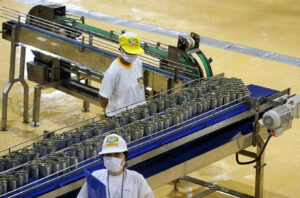Manufacturing output climbed in April, fueled by seasonal demand rise and the growth in the production of food products, the Philippine Statistics Authority (PSA) reported on Friday.
Preliminary results of the Monthly Integrated Survey of Selected Industries showed that April factory output — as measured by volume of production index (VoPI) — rose by 6.7% year on year, a reversal from the revised 5.8% contraction in March but still slower than the 8% growth last year.
On a monthly basis, the April VoPI fell by 0.5% from the revised 0.7% growth in March. Stripping out seasonality factors, output grew by 1.8%, a turnaround from the 4.7% decline the previous month.
For the January to April period, VoPI growth averaged 0.5%, slower than 5.9% in the same period a year ago.
Analysts said that the faster April manufacturing output growth was due to the seasonal demand.
“It’s the cyclical pattern,” Philippine Exporters Confederation, Inc. (Philexport) President Sergio R. Ortiz-Luis, Jr. said in a phone call interview. “Demand falls in the first quarter as orders at yearend were met, and it rebounds after. This led to the higher April manufacturing output.”
Similarly, Cristina S. Ulang, research head at First Metro Investment Corp., said in a Viber message that the growth was due to factory production picking up during the April season.
“April is the start of the summer vacation. [It is a] positive backdrop for travel, driving and tourism, leisure, construction, and a notable catch up in [infrastructure] spending and the start of the seasonal second quarter mining shipments,” she added.
In comparison, the country’s April manufacturing purchasing managers’ index (PMI) by S&P Global that month also grew, reaching 52.2 from 50.9 in March. However, it eased to 51.9 in May.
A PMI reading below 50 marks a contraction in the manufacturing sector, while 50 marks an expansion.
The PSA attributed the leap in April’s factory output to the growth in the industry division of food products which rose by 6.8% from a 13.2% decline in March. Food products account for the the bulk (18.7%) of total manufacturing.
Also contributing to the rise in April’s factory output growth was the production of transport equipment, which grew by 5.1% from -12.0 %, and fabricated metal products, except machinery and equipment (up by 32.3% from -3.1%).
Out of the remaining 19 industry divisions,12 posted annual growth, while seven declined.
The capacity utilization rate in April eased to 75.2%, higher than the 72.5% rate last year but a tad slower than March’s 75.3%.
All 22 sectors had rates higher than 60% capacity utilization rate in April, surpassing the minimum 50% threshold.
Ms. Ulang expects expansion to continue in the coming months, albeit in slight moderation, due to the volatility of the peso.
The peso finished at P58.61 per dollar on Thursday, strengthening by 16.9 centavos from its Wednesday close. The Wednesday finish of P58.78 of the local unit was its lowest in 19 months.
“Inflation further accelerating in May and interest rates yet to adjust lower [are also factors to consider],” she said.
May inflation accelerated to a six-month high of 3.9%, faster than the 3.8% recorded in April.
The Bangko Sentral ng Pilipinas kept its benchmark rate at 6.5% in the May policy meeting. The central bank raised borrowing costs by a cumulative 450 bps from May 2022 to October 2023 to combat inflation.
Meanwhile, Mr. Ortiz-Luis expects continued growth in the manufacturing sector in spite of the weakening peso and given that no disruption occurs in the supply chain. — Andrea C. Abestano
